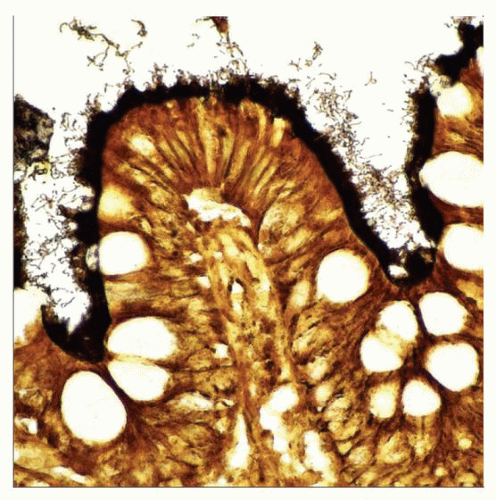Spirochetosis
Laura W. Lamps, MD
Key Facts
Clinical Issues
Most commonly affects colonic mucosa in men with HIV/AIDS
Most common symptom is diarrhea, but unclear whether spirochetosis actually causes symptoms
Antimicrobial and antidiarrheal therapy
Conflicting studies: Some have shown no improvement with therapy; others have shown significant symptomatic improvement
Macroscopic Features
Colonoscopy usually completely normal
Microscopic Pathology
Fuzzy, “fringed” basophilic layer of organisms at luminal surface of colonic epithelium
Organisms stain with silver impregnation stains (Warthin-Starry, Dieterle, Steiner)
Usually no associated inflammatory infiltrate
 A fuzzy band of spirillar organisms at the luminal surface of the colonic epithelium is seen, which characterizes intestinal spirochetosis. |
TERMINOLOGY
Abbreviations
Intestinal spirochetosis (IS)
Definitions
Noninvasive infection by a group of related organisms
Spirochetes Brachyspira aalborgi and Brachyspira pilosicoli responsible for most cases
Patients may have 1 or both of these species
Prevalence 2-16% in Western nations
Most commonly seen in patients with HIV/AIDS
Higher in developing countries
ETIOLOGY/PATHOGENESIS
Common Associations
Men with HIV/AIDS
Most common association
Clinical significance has been hotly debated
Patients often have other concomitant infections, confounding clinical scenario
Many patients with spirochetosis appear to respond to antibiotic therapy, however
Patients with diverticular disease, chronic idiopathic inflammatory bowel disease
Stay updated, free articles. Join our Telegram channel

Full access? Get Clinical Tree



